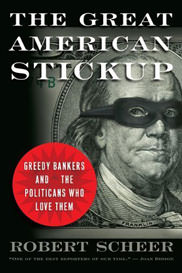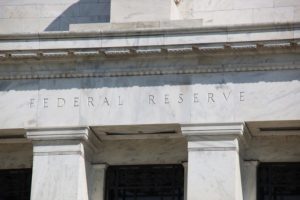How Clinton Democrats Killed Roosevelt’s Dream of the Affordable Home
The following excerpt from Robert Scheer's book "The Great American Stickup" details the perversion of Fannie Mae and Freddie Mac and is particularly relevant this election season, as it explains the connection between Clinton "progressives" and the 2008 housing meltdown that impoverished millions.
Editor’s note: The following excerpt from Robert Scheer’s book “The Great American Stickup: How Reagan Republicans and Clinton Democrats Enriched Wall Street While Mugging Main Street” details the perversion of Fannie Mae and Freddie Mac. This is particularly relevant to explain the connection between Clinton “progressives” and the 2008 housing meltdown that impoverished millions. Copyright © 2010. Available from Nation Books, an imprint of Perseus Books, a division of PBG Publishing, LLC, a subsidiary of Hachette Book Group, Inc.
Chapter 7: Poverty Pimps
When the Bush administration was forced in the fall of 2008 to bail out the “government sponsored enterprises” or GSEs, as the mortgage buying companies of Fannie Mae and Freddie Mac are referred to, grateful conservatives finally had what appeared to be a convenient government villain. Working backwards from the GSEs’ founding mandate to support the market for middle- and low-income buyers by buying up mortgages from lenders and then repackaging them as securities, longtime critics were only too excited to blame do-gooder liberalism as the fly in the ointment of capitalism. Specifically, House Financial Services Committee chair Barney Frank was singled out as having pressured the GSEs to make loans to unqualified poor people—especially minorities—who then defaulted and caused the economic downturn.
“Taxpayers are now on the hook for as much as $200 billion to rescue Fannie Mae and Freddie Mac, and if you want to know why, look no further than the rapid response to this bailout from House baron Barney Frank,” wrote the Wall Street Journal in a September 9, 2008, editorial. “Mr. Frank wants you to pick up the tab for its failures, while he still vows to block a reform that might prevent the same disaster from happening again.”
The editorial is worth quoting at length because it summarizes a perspective broadly held and argued by conservatives. It correctly criticizes Frank for statements he made in 2004, when Fannie Mae revealed a “multibillion-dollar financial ‘misstatement.’ ” Frank had said that he felt that despite this, the mortgage lender was not a danger to taxpayers. “I think Wall Street will get over it,” Frank had said. The Journal mocked this response—“Yes they’re certainly ‘over it’ … now that Uncle Sam is guaranteeing their Fannie paper, and even Fannie’s subordinated debt.” The newspaper then ridiculed Frank for his criticism of conservative economic policies, saying that what really blocked reform was Frank’s insistence that “any reform be watered down and not include any reduction in their MBS [mortgage backed security] holdings.”
Some liberal pundits, most notably the New York Times’ Paul Krugman, attempted to play down the role of Freddie and Fannie, arguing, incorrectly, that they only made proper “conforming” loans. But that was false, for the definition of conforming is whatever Freddie and Fannie approved of, and those turned out to be as disastrously irresponsible as any.
The free-market conservatives are right in criticizing those GSEs, for they were highly culpable, and the grand swindle could not have taken place without them. But they are wrong in describing the GSEs led by Fannie Mae and Freddie Mac as do-gooder public entities; in reality they are privately owned, profit-driven companies that richly reward their executives for stock market success. That is the source of much confusion in this debate; the top executives of the GSEs were compensated as handsomely, and often more so, than any other corporate executives, but because of their original government sponsorship, they made for convenient targets for the wrath of free-market ideologues.
The man who understood that best was a whistleblower in the mold of Brooksley Born. Like her, Armando Falcon Jr. was appointed by the president to regulate entities led by people who had the political clout to prevent any meaningful regulation. Falcon was director of the Office of Federal Housing Enterprise Oversight (OFHEO), the underfunded and government agency assigned to monitor the federal housing behemoths.
Thus there was considerable irony when, a year and half after the crash he had warned against, Falcon found himself on April 9, 2010, before the bipartisan Financial Crisis Inquiry Commission, which included Brooksley Born, unraveling his part of this tale of woe. His testimony was a devastating indictment of the culture of corruption that was as bipartisan in origin as was the makeup of the commission now seeking answers. He had attempted to regulate agencies dominated by leaders drawn from Democratic ranks during a Republican administration, but as with Born earlier, he was done in by both sides.Yet while Falcon had come to be supported by conservatives who never did have much love for the hybrid GSEs he was attempting to regulate, he was clear that the cause was not the pathetic ambitions of the ordinary folks attempting to buy homes they couldn’t properly afford. Rather, it was the greed of the powerful. Falcon cut through the false dichotomy that cast blame for the banking debacle either on the huge totally private financial moguls or their government-sponsored rivals but not both. He said they were, in terms of motivation and impact, one and the same.
Conservatives make much of the affordable housing goals of the GSEs, endorsed by George W. Bush as well as Bill Clinton, as the cause of the irresponsible lending that occurred these past decades. But Falcon in his testimony shot that one down. Asked by the commission to testify on the impact of those goals on the GSE issue, Falcon responded: “Your letter also asked me about the impact of affordable housing goals on the enterprises’ financial problems. In my opinion, the goals were not the cause of the enterprises’ demise. The firms would not engage in any activity, goal fulfilling or otherwise, unless there was a profit to be made. Fannie and Freddie invested in subprime and Alt A mortgages in order to increase profits and regain market share. Any impact on meeting affordable housing goals was a byproduct of the activity.”
Nevertheless, it remains true that the GSEs were the major purchasers and packagers of securities based on mortgages, and they acted with the implicit guarantee that the bonds they sold were backed by the federal government. When the meltdown occurred, that guarantee went from implicit to explicit, and the federal government moved in and backed all of those toxic obligations. It also fueled the conservative attack that two key executives of Fannie Mae, the larger of the two agencies, were also influential players within the earlier Clinton administration and had led the fight to prevent any meaningful regulation of those mortgage-based securities. What the conservatives insist on ignoring is that while Fannie and Freddie were originally government sponsored to make moderate-priced housing more accessible, they had long since shed any of the trappings or restraints of a government agency.
Over the decades since 1938, when Fannie Mae, the first of the GSEs, was created, they had in effect gone from being public to private enterprises, with the companies’ and their top executives’ fortunes dependent on stock market valuation of their publicly traded shares.
In that spirit, the top officials of the two agencies were rewarded not in the manner of heads of huge government agencies but rather at easily thirty times the highest pay of any such executive, including the president himself. But they did still require the acquiescence of Congress, which retained the power to pull their federal charters through legislation. Preventing that outcome, or indeed any serious regulation of the GSEs, became the major object of their lavishly funded lobbying operation. Not surprisingly then, the top executives tended to be drawn from the ranks of political operatives rather than from more traditional financial backgrounds. It is also true, as conservatives are wont to point out, that the two men who most shaped the actions of Fannie Mae, the bigger of the two agencies, were drawn from the Democratic side. But they couldn’t have done this damage to the housing market alone and instead functioned like, and indeed were in close partnership with, the other moguls in the mortgage business.
The tale of their alliance with leaders of a runaway mortgage industry, particularly the industry-dominant figure of Countrywide’s Angelo Mozilo, who also cofounded subprime sinkhole IndyMac Bank, which failed as well, is central to the debacle that ensued. But to mention the guys on the quasi-government–sponsored side and not their key partners in the fully privatized mortgage business is to deny reality.In fact, it is the dance of the private with the public that is the norm in what we naïvely refer to as our “free enterprise system”—be it agribusiness, the defense industry, telecommunications, or, as in this case, the financial sector. All of these industries operate in an environment of government rules that their lobbyists get to help write, and all succeed through an ability to negotiate the regulatory environment that results from those laws.
At this dance, Countrywide’s Mozilo was a virtuoso, but he had two key partners every bit as skilled as he was on the GSE side of things. For the past two decades, one of the two main leaders of the government-sponsored agencies was James A. Johnson, who started political life working for Minnesota Democratic senator and later vice president Walter Mondale and parlayed that into a job running Fannie Mae that paid him more than $6 million a year.
The Washington Post in a fawning tribute to Johnson on March 27, 1998, shortly before he retired from Fannie Mae, referred to him as “one of the most powerful men in the United States.” The Post’s reporter added: “As chairman of three preeminent institutions in the nation’s capital—the government-sponsored home mortgage behemoth known as Fannie Mae, the peerless think tank known as the Brookings Institution, and the mammoth performing arts emporium known as the Kennedy Center—he has positioned himself to exert enormous influence over the country’s economic, intellectual and cultural lives. And while he’s at it, he’s getting seriously rich.”
A far less flattering portrait a year earlier by Matthew Cooper in Slate, titled “A Medici with Your Money,” pointed out, “he is not a philanthropist with his own money. The fount of Johnson’s generosity is Fannie Mae’s foundation, funded out of its profits.” The Slate article had it right, noting the connection between the vast public outreach of Johnson’s operation and his goal of retaining government backing for an enormous engine of profit from which he benefitted mightily: “What makes Fannie Mae special is that it is essentially the taxpayers’ money that Johnson is giving away. Fannie Mae enjoys a massive government subsidy, and its charitable contributions are part of a vital corporate strategy to keep it that way.”
Johnson’s expansive public relations strategy was maintained, indeed expanded, by the man who would replace him, his deputy Franklin Delano Raines. Prior to working for Johnson, Raines had been highly compensated as a Wall Street financial executive. At Fannie Mae he was earning $2.25 million when Clinton appointed him to be director of the Office of Management and Budget at an annual salary of $148,400. The president quipped that Raines would be joining “other successful people who came into this Administration to help save the middle class and when they leave they will be part of it.”
Not quite. After Raines left two years later in 1998 and replaced Johnson as the chair of Fannie Mae, he would be paid $36 million in compensation for his last three years of service, which extended well into the Bush years, before being forced out in 2004 amid an accounting scandal. He left with a $25 million pension, an $8.7 million deferred compensation plan, another $5.5 million in stock options, and a guaranteed income of $1.4 million, which would be paid to him and his wife until both died. Is that what Bill Clinton considers middle class?
Keep up with Robert Scheer’s latest columns, interviews, tour dates and more at www.truthdig.com/robert_scheer.
Your support matters…Independent journalism is under threat and overshadowed by heavily funded mainstream media.
You can help level the playing field. Become a member.
Your tax-deductible contribution keeps us digging beneath the headlines to give you thought-provoking, investigative reporting and analysis that unearths what's really happening- without compromise.
Give today to support our courageous, independent journalists.








You need to be a supporter to comment.
There are currently no responses to this article.
Be the first to respond.